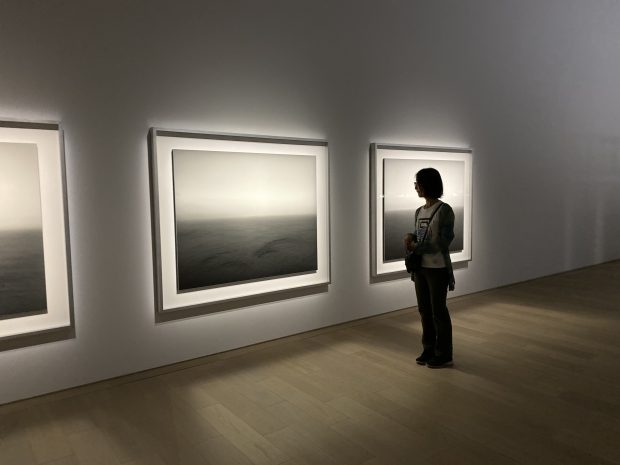09/4/13「杉本博司の歴史の歴史展」大阪 国立国際美術館

09/4/13「杉本博司の歴史の歴史展」大阪 国立国際美術館
オープニングレセプションに行った。いきなり化石の陳列、エッ!杉本博司といえば写真家と私はインプットしているのでなんでや?と、ゲンダイビジュツは落とし穴があるからご用心!アンモナイトやザリガニ、こうもり、、、ともかくも美しい、そして繊細だ。造りものかと目を凝らすがパンフレットに始新世5500万年とか4億4500万年と記されている。しかし何で化石が展示されているの?との疑問符を抱きながら次のコーナーに行くと見たことのある杉本の建築の写真ありやっぱり杉本博司展だと合点。そして古い仏像が、古色蒼然と表装された仏画や金泥の経典がある。昨日行った妙心寺展の京都博物館と錯覚しそうなった時、地平線の海のシリーズコーナーに。これは何度目にしても圧倒され、惹きこまれる。
芸術にとって生命の根源、海は永遠のテーマであり、名作も多々ある。しかし海の本質である<生命の根源>としてこれほどインパクトのある作品は思い付かない。SUGIMOTOの海はまさに地球上に生命体が生じる時の海なのだ。じっと見ていると私の脳幹の記憶装置が超高速度で巻き戻されるのを実感する。
すると隕石、アポロの月面活動の写真が、月の写真の軸の前の三宝には月の石が、何で?ホンマニ月の石かいな?とゆう疑問も猜疑心もインパクトある雰囲気で押し込まれてしまう。
最後にマルセル・デュシャンの肖像とラージグラスが、なるほど合点!これが杉本博司を解くキーなのだ。
杉本は現代のデュシャン。デュシャンが便器や鍬やスコップを展示して認知の常識を鋭く衝いたように、SUGIMOTOは俗世間では趣味や考古学と分類され日常生活から遊離して認識している概念に<骨董・化石など時間の蓄積>した物(ブツ)を突きつける。そして誰しもが宇宙とゆうか神とゆうかの法則の中に在ることを知らしめる。決してそのルールから逃れることは出来ないものを。歴史は時間の集積。時間は如意棒、瞬時と永遠の間に存在する。そしてこの如意棒は残酷無慈悲だ。誰もこの支配から逃れることはできない。広大な始皇帝の墓もピラミットも権力者がこの如意棒から逃れようとしたあがきの証なのだ。
SUGIMOTOに触発された私の脳は勝手に飛躍していきそうだ。
これほど脳味噌に刺激を承けた展覧会は久しく無い。展覧会とゆう概念を越えている。SUGIMOTOの無尽に駆け巡る宇宙観に翻弄される仕掛け場だった。
それにしても昨日は京都・智積院で長谷川等伯の障壁画を独り占め(ホント!国宝を独り占めできるなんてさすが KYOUTO、もしTOKYO で観たら長蛇の列で3分がいいとこ)利休好みの庭園も貸しきり、贅沢は身近にあり、このような時は酷い如意棒からも解き放たれているのではなかろうか。
